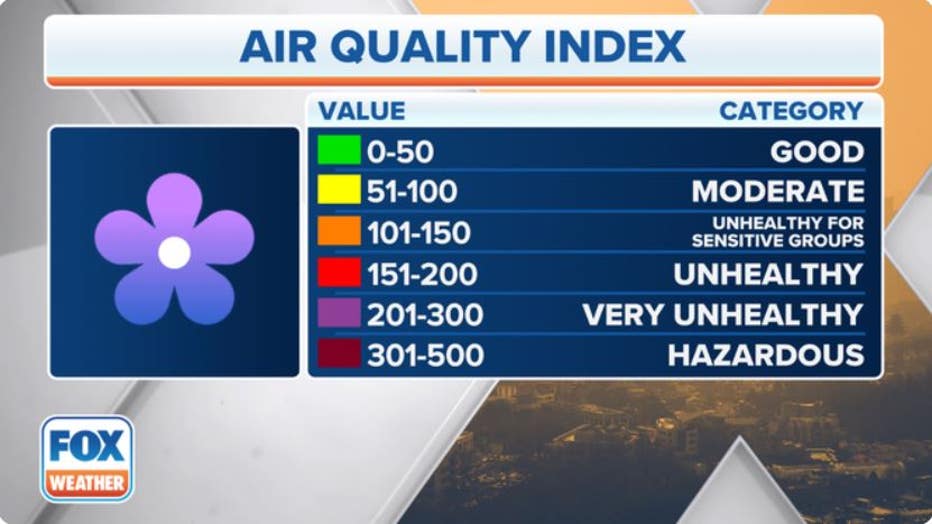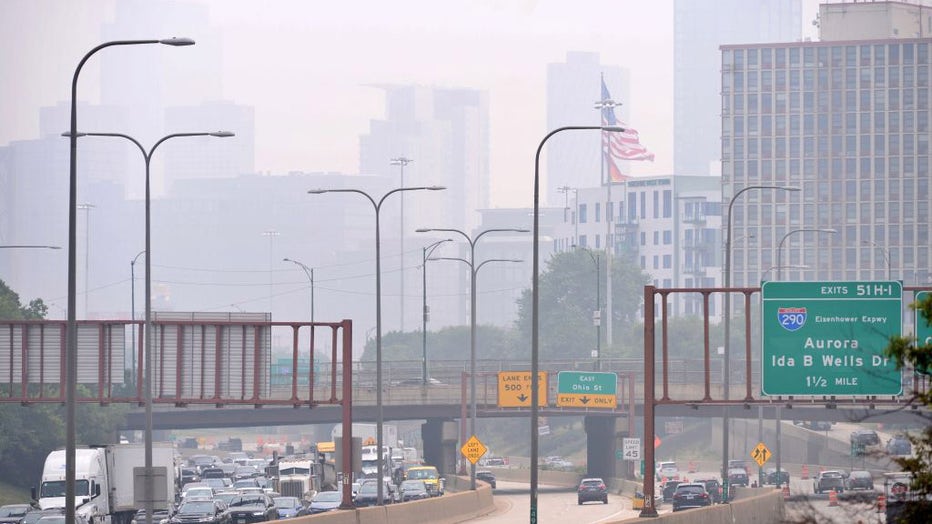How is air quality measured?
Canadian wildfires causing air quality issues across the U.S
As Canada is experiencing one of its worst wildfire seasons, parts of the U.S continue to be impacted. Detroit air quality ranked one of the worst in the world as of Wednesday. LiveNOW from FOX host Zach Horner spoke to FOX 2 Detroit's Robin Murdoch on the air quality and how citizens can protect themselves. More LiveNOW from FOX streaming video.
Air quality has become a hot topic in recent years. After parts of the U.S. dealt with some of the worst air quality in recorded history in June, you might be wondering how it’s actually measured.
Here are seven facts you should know about measuring air quality.
1. Air quality is measured with the air quality index
The air quality index, better known as AQI, as we know it today was released in 1999, according to AirNow.gov. It has gone through several updates over the years, but the goal has always been the same – to offer people an easy-to-understand daily report about the air they’re breathing.
The AQI ranges from 0 to 500 and has six color-coded categories to correspond to a different level of health concern, according to AirNow.gov. Basically, lower numbers equate to better air quality and higher numbers equate to poorer air quality.
THE AIR QUALITY INDEX EXPLAINED: WHAT AIR QUALITY IS BAD?

The air quality index ranges from 0 to 500 and has six color-coded categories to correspond to a different level of health concern. (FOX Weather)
2. There are six common air pollutants
Air quality managers monitor six common air pollutants: particle pollution, ozone, carbon monoxide, sulfur dioxide, nitrogen dioxide and lead, with the first two comprising the bulk of pollutants.
The reporting period is different for each air pollutant in the AQI, according to AirNow.gov. For example, the AQI for ozone is valid for eight hours, while the AQI for particle pollution is valid for 24 hours.
3. Lead is not included in daily air quality reports
Although lead is monitored by the Environmental Protection Agency, it’s not included in the daily AQI reports. According to an EPA spokesperson, that’s because the effects of lead pollution are cumulative.
"The AQI focuses on health effects that may be experienced within a few hours or days," the spokesperson said in a written statement. "Health effects from airborne lead more usually accumulate over longer time periods, so daily reports about air quality and potential health effects from lead exposure are not possible."
THESE 6 AIR POLLUTANTS CAN CAUSE PROBLEMS FOR YOUR HEALTH
4. When air quality is poor, an air quality action day might go into effect
An air quality action day, sometimes called an air quality alert day, is put into effect when the AQI reaches unhealthy ranges.

A view of the smoky air in downtown Chicago seen from Highway 90 as the air quality is at unhealthy levels due to smoke from Canadian wildfires in Chicago, United States on June 27, 2023. (Photo by Jacek Boczarski/Anadolu Agency via Getty Images)
There are numerous air pollution control agencies across America, each having slightly different terminology for such days and using varying AQI levels when considering them.
WHAT IS AN AIR QUALITY ACTION DAY?
According to AirNow.gov, air quality action days are most commonly put into effect when the AQI is expected to be unhealthy, or Code Red (AQI value of 151 to 200). In this case, everyone should reduce exposure to air pollution, especially the members of the sensitive groups for that day’s particular pollutant.
AirNow.gov provides several suggestions at this link on what you can do to help keep the air cleaner every day.
5. Instruments on the ground and in space collect air quality data
Measurements of air pollutant concentrations are taken at more than 4,000 monitoring stations owned and operated mainly by state environmental agencies, according to the EPA. These agencies send their hourly or daily pollutant concentration measurements to the EPA's Air Quality System database.
In addition, satellites orbiting the Earth collect information about air quality. For example, according to NOAA, satellites in NOAA’s GOES-R Series monitor the particle pollution in the atmosphere.
The Joint Polar Satellite System (JPSS) also collects information about particles in our air. These include smoke particles from wildfires, airborne dust during dust and sand storms, urban and industrial pollution and ash from erupting volcanoes, NOAA said. The JPSS series of satellites can also measure ground-level ozone.
WHAT TO DO WHEN WILDFIRE SMOKE SMOTHERS YOUR AREA AND HOW TO KEEP YOUR HOME'S AIR CLEAN
6. Air quality is affected by the seasons
When temperatures soar in the summer, the air quality in large cities usually takes a turn for the worse – especially ozone levels.
Ozone is good in the higher levels of the atmosphere, where the chemical protects us from harmful ultraviolet rays from the sun.
But near the Earth’s surface, ozone is the main component of smog and can trigger a number of health issues, including chest pain, coughing, throat irritation and congestion, according to the Puget Sound Clean Air Agency. Smog can even worsen bronchitis, emphysema and asthma and reduce lung function.
Ozone is at its worst on those hot summer days, when the hot sun "cooks" everyday emissions from motor vehicles, industry, paints, solvents and gasoline fumes, according to the PSCAA.
In the summer and especially during extreme heat waves, ozone often reaches dangerous levels in cities or nearby rural areas, according to the University Corporation for Atmospheric Research in Boulder, Colorado.
Chicago air quality: worst in the world due to smoke from Canadian wildfires | LiveNOW from FOX
Chicago has the worst air quality of any city in the world today, according to the World Air Quality Index. Smoke from Canadian wildfires was pushed into the area, dropping air quality to unhealthy levels. More LiveNOW from FOX streaming video
But in some colder climates, winter doesn't escape polluted air either – though, in this case, it's not ozone but tiny particulates that degrade the air quality, such as from wood smoke out of a fireplace. Idling cars to defrost or keep them warm also increases the amount of air pollution, UCAR noted.
"We can get very strong inversions in mountainous regions, for instance, and an inversion is very good at trapping pollutants down to the surface," said Joost de Gouw, a chemistry professor at the University of Colorado Boulder and a fellow at the Cooperative Institute for Research in Environmental Sciences. "So in a lot of areas – for instance, in Salt Lake City – the air quality is the worst in the winter because the airspace is trapped."
An inversion is when temperatures rise with height, with warm air sitting overtop of colder air below. Since cold air is denser than warm air, it is trapped near the Earth’s surface.
Some areas will issue air quality burn bans when fireplace smoke could become an issue during strong wintertime inversions.
7. Sources of air pollution have changed over the years
Most people think air pollution comes from car exhaust or industrial production, and this is a correct assumption. Wood smoke from either wildfires or home fireplaces can also contribute to degraded air quality due to an increase in tiny particles in the air.
But the sources of air pollution have changed over the years, scientists say, because of some tighter regulations.
WHERE DO OUR TOP AIR POLLUTANTS COME FROM?
"I would say 20 years ago, the top three (air quality polluters) were transportation/motor vehicles, power generation and industry," de Gouw said.
But the Clean Air Act, passed in 1970 and amended in 1977 and 1990, has reduced pollution from those sources.
"And so now, other sources that haven't been addressed so much are coming to the top of the list," said de Gouw.
Many of those are chemical products we use every day.
"For instance, all the shampoos and deodorants that we use in our daily lives; all the bottles we have in our homes that come from the automotive shop, the grocery store and the garden store, basically," he said.
Even agriculture can contribute to air quality issues.
"There's a lot of ammonia that comes from animal feedlots," said de Gouw. "We smell those here on a regular basis in Colorado. And so, yeah, so the number of sources has really diversified because we've been so successful in skimming off the top ones, you might say."
Get updates to this story on FOXWeather.com.

